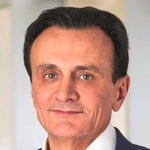
AstraZeneca PLC
LSE:AZN

AstraZeneca PLC





AstraZeneca PLC stands as a formidable entity in the global pharmaceutical landscape, adeptly navigating the intricate dance of innovation and commerce. Emerging from a merger between Sweden's Astra AB and the UK's Zeneca Group in 1999, the company has carved a niche through its relentless pursuit of cutting-edge medical solutions. Central to its operations is a sophisticated ecosystem of research and development, where thousands of scientists tirelessly explore the expansive frontier of biotechnology. The lifeblood of AstraZeneca's growth is its robust pipeline, where potential life-saving medicines traverse an arduous journey from laboratory benches to clinical trials, and eventually, regulatory approval. This rigorous process underscores its commitment to addressing complex diseases in areas such as oncology, cardiovascular, and respiratory health – domains marked by high unmet medical needs and significant market demand.
The commercial prowess of AstraZeneca is equally vital to its success narrative. With a global reach spanning over 100 countries, the company leverages its advanced production facilities and strategic partnerships to deliver its pharmaceutical breakthroughs to those in need. Revenue generation is predominantly through the sale of prescription drugs, with blockbuster medications serving as pivotal financial pillars. These products, once approved, are strategically marketed to healthcare providers, ensuring they gain traction in various markets. AstraZeneca's approach is finely tuned to balance the scale of mass production with the nuance of catering to specific regional demands, maintaining a competitive edge in a crowded pharmaceutical landscape. Through these intricacies of innovation, production, and strategic market positioning, AstraZeneca not only generates substantial revenues but also reinforces its mission to improve patient health outcomes worldwide.
Earnings Calls
Management

Pascal Soriot is the Chief Executive Officer (CEO) of AstraZeneca PLC, a global biopharmaceutical company. He was born on May 23, 1959, in France. Dr. Soriot holds a Doctor of Veterinary Medicine (D.V.M.) degree from the École Nationale Vétérinaire d'Alfort in Paris, and he also earned a Master of Business Administration (M.B.A.) from HEC Paris, one of Europe’s leading business schools. Pascal Soriot began his career in the pharmaceutical industry with a range of roles in sales, marketing, and management. Before joining AstraZeneca, he worked with several other major pharmaceutical companies. He spent 14 years at Aventis (now part of Sanofi) in various senior roles and was later appointed as Chief Executive Officer of Roche's pharmaceuticals division. His experience at Roche included managing their commercial activities and product development strategies on a global scale. In October 2012, Pascal Soriot became the CEO of AstraZeneca. Under his leadership, the company focused significantly on research and development, leading to the strengthening of its pipeline, especially in the areas of oncology, cardiovascular, renal, and metabolic diseases. His leadership has been pivotal in AstraZeneca's involvement in the development of the COVID-19 vaccine, produced in partnership with the University of Oxford. Pascal Soriot is recognized for his strategic vision and commitment to scientific innovation and has been instrumental in driving AstraZeneca’s growth and transformation into a leading global science-led biopharmaceutical company.

Dr. Aradhana Sarin is a distinguished business executive and medical doctor known for her role as the Chief Financial Officer (CFO) at AstraZeneca PLC, a global, science-led biopharmaceutical company. She took on the role of CFO in August 2021 following AstraZeneca's acquisition of Alexion Pharmaceuticals, where she also served as CFO. Dr. Sarin has a diverse professional background that combines extensive experience in both medicine and finance. She completed her medical training in India and subsequently practiced as a physician in cardiology. Transitioning from medicine to finance, Dr. Sarin pursued an MBA from Stanford University, enhancing her expertise in business management and financial strategy. In her finance career, Dr. Sarin has held key roles at major financial institutions such as Merrill Lynch and UBS, where she honed her skills in investment banking, capital markets, and mergers and acquisitions. Her experience in finance, coupled with her medical background, has provided her with a unique perspective that she leveraged effectively in her executive roles. During her tenure at Alexion Pharmaceuticals, she played a pivotal role in strategic operations, financial planning, and business development, particularly in overseeing the successful acquisition by AstraZeneca. At AstraZeneca, she continues to contribute to the company's strategic financial planning, working towards enhancing the company's financial performance and supporting its mission to deliver life-changing medicines. Her leadership is integral to navigating the complexities of the pharmaceutical industry and guiding AstraZeneca's fiscal strategies globally.

Pam P. Cheng is a prominent figure in the pharmaceutical industry, known for her significant contributions at AstraZeneca PLC. She holds the role of Executive Vice President of Global Operations and IT at AstraZeneca. In this capacity, Cheng oversees a broad spectrum of the company's operations, including manufacturing, supply chain, procurement, and IT operations, all crucial areas that ensure the efficient delivery of AstraZeneca's healthcare solutions globally. Before joining AstraZeneca in 2015, she had an extensive career at Merck/MSD, where she worked for 18 years in various leadership roles. At Merck, Cheng was instrumental in driving global manufacturing and supply chain strategies. Her expertise in these areas helped to enhance operational efficiencies and support business growth objectives. Cheng holds a degree in chemical engineering from Stevens Institute of Technology in New Jersey, and an MBA in marketing from Pace University in New York. Known for her strategic acumen and leadership skills, she is highly regarded in the industry. Under her leadership, AstraZeneca has made significant strides in optimizing its global supply chain and enhancing its IT capabilities to support innovative healthcare solutions. Cheng's work has been pivotal, especially in scaling up production and distribution, which has been crucial in times of increased demand for medical supplies and innovations. Her influence extends beyond her technical expertise as she also advocates for diversity and inclusion within the industry.

Andrew P. Barnett serves as the Group Financial Controller at AstraZeneca PLC. In this role, he is responsible for overseeing the company's financial reporting, ensuring compliance with financial regulations, and managing the financial planning and analysis. Barnett plays a crucial part in maintaining the financial integrity of AstraZeneca and supports the company's strategic financial decisions. With a strong background in finance and extensive experience in the pharmaceutical industry, Barnett contributes to AstraZeneca's financial management through rigorous financial oversight and strategic guidance. His expertise helps support the company’s mission to push the boundaries of science for delivering life-changing medicines to patients. Throughout his career at AstraZeneca, Barnett has been instrumental in driving financial efficiency and supporting the company’s growth initiatives. His work involves collaborating with senior executives to align financial strategies with the broader corporate goals, thereby ensuring sustainable financial health for the organization.
Gonzalo Viña is an accomplished communications professional who served as a key figure at AstraZeneca, one of the world's leading pharmaceutical companies. In his role, he was responsible for managing corporate affairs and communications, helping to shape the public narrative and internal messaging of the company during a dynamic period marked by major developments in pharmaceutical innovation and global health challenges. Viña played an integral part in overseeing AstraZeneca's communication strategies, ensuring transparent and effective messaging both internally among employees and externally to stakeholders, including the media, investors, and the general public. His expertise in strategic communications was particularly crucial during the global rollout of AstraZeneca's COVID-19 vaccine, where clear and accurate information dissemination was vital. Before his tenure at AstraZeneca, Gonzalo Viña built a strong background in journalism and communications, having worked with notable organizations where he honed his skills in delivering compelling narratives and managing complex information environments. His experience spans various sectors and showcases his ability to adapt to diverse communication challenges while maintaining the integrity and reputation of the organizations he represents. Gonzalo Viña's contributions to AstraZeneca highlight his expertise in corporate communications and his ability to manage sensitive information and high-stakes scenarios effectively.

Dr. Ruud Dobber is a prominent figure in the pharmaceutical industry and serves as a key executive at AstraZeneca PLC. With a well-established career in the healthcare sector, Dr. Dobber has accumulated extensive experience in leading business operations and driving strategic initiatives within the company. Dr. Dobber holds a Ph.D. in immunology from Leiden University in the Netherlands, where he conducted significant research contributing to advancements in the field. His academic background laid a strong foundation for his subsequent career in pharmaceuticals. At AstraZeneca, Dr. Dobber has held several influential positions, contributing to the company's growth and success. One of his notable roles includes serving as the Executive Vice President of the BioPharmaceuticals Business Unit, where he was responsible for overseeing the company’s commercial operations related to cardiovascular, renal, and metabolism (CVRM) and respiratory and immunology (R&I) medicines. His leadership in these areas has been crucial for the development and commercialization of vital therapies. Throughout his career, Dr. Dobber has been recognized for his strategic vision and his ability to foster innovation within large-scale pharmaceutical operations. His contributions have not only propelled AstraZeneca's business objectives but have also had a positive impact on patient outcomes globally, particularly through the advancement of key therapeutic areas. Dr. Dobber is also known for his commitment to driving sustainable healthcare solutions and his efforts in collaborating with international stakeholders to address global health challenges.

Dr. Susan Mary Galbraith, M.D., Ph.D., is a prominent figure in the pharmaceutical industry, currently serving as the Executive Vice President of Oncology Research and Development at AstraZeneca PLC. She is noted for her extensive experience and leadership in cancer research and drug development. Dr. Galbraith earned her medical degree from the University of Manchester and subsequently pursued a Ph.D. Her early career included clinical training in oncology, providing her with valuable frontline experience in treating cancer patients. She worked at the Institute of Cancer Research and the Royal Marsden Hospital, where her focus was on developing new cancer therapies. Joining AstraZeneca in 2010, Dr. Galbraith has played a vital role in advancing the company's oncology pipeline, emphasizing innovative and targeted therapies aimed at improving outcomes for cancer patients globally. Under her leadership, the team has focused on four scientific platforms: immuno-oncology, tumor drivers and resistance, DNA damage response, and antibody-drug conjugates. Dr. Galbraith is well-regarded for her strategic vision and commitment to science-driven innovation. Her contributions have made a significant impact on the field of oncology, strengthening AstraZeneca's position as a leader in the development of cancer therapeutics. Known for her passion for collaboration and mentorship, Dr. Galbraith continues to inspire and guide new generations of researchers in the pharmaceutical industry.

Leon Wang is the Executive Vice-President responsible for the International Region at AstraZeneca PLC. He joined AstraZeneca in 2015 and plays a crucial role in expanding the company's operations across multiple international markets, particularly focusing on emerging markets where there is significant potential for growth in the pharmaceutical industry. Before joining AstraZeneca, Leon Wang held several leadership positions with increasing responsibilities at Roche, contributing to his extensive experience in the healthcare and pharmaceutical sectors. His skills in strategic planning, market development, and business management have been integral to AstraZeneca's success in the regions under his leadership. In addition to his role at AstraZeneca, Leon Wang is known for his work in fostering innovation and collaboration within the healthcare industry, often emphasizing patient-centric approaches and partnerships that enhance access to medical treatments and improve health outcomes across diverse populations. His leadership style is considered dynamic and forward-thinking, tailored to the complexities and specific needs of the international markets he oversees.

Iskra Reic is a notable executive at AstraZeneca PLC, where she has served as Executive Vice-President, Europe & Canada. She joined AstraZeneca in 2001 and has since held several key leadership roles within the company, contributing significantly to its commercial success and strategic direction. Her extensive experience in the pharmaceutical industry spans multiple markets and therapeutic areas. Before becoming Executive Vice-President, Iskra Reic held positions such as Vice President of Specialty Care in Europe and roles in different regional markets, including Central and Eastern Europe. She is known for her strong focus on collaboration, innovation, and improving patient outcomes through strategic healthcare solutions. Reic has an academic background in both business and pharmacy, holding a Master of Pharmacy from the University of Zagreb and an Executive MBA. Her expertise in pharmaceutical sciences, coupled with her business acumen, has been instrumental in leading initiatives to expand AstraZeneca's market presence across Europe and Canada. Iskra Reic’s leadership style is characterized by her commitment to fostering an inclusive workplace culture and driving AstraZeneca’s mission to push the boundaries of science to deliver life-changing medicines.

David Fredrickson is a prominent executive in the biopharmaceutical industry, currently serving as the Executive Vice President of the Oncology Business Unit at AstraZeneca PLC. He has been with the company since 2017, overseeing the strategic and operational aspects of AstraZeneca's oncology portfolio. Fredrickson's leadership is marked by a strong focus on innovation and collaboration, driving significant growth in AstraZeneca's oncology division. He has played a critical role in advancing the company's cancer treatment pipeline, emphasizing precision medicine and the development of targeted therapies. Before joining AstraZeneca, Fredrickson held various leadership positions in the pharmaceutical industry, gaining extensive experience in international markets and commercial strategy. His career includes roles at Roche and Genentech, where he contributed to the development and commercialization of several successful oncology products. Fredrickson is known for his commitment to improving patient outcomes and fostering a working environment that encourages scientific excellence and patient-centric approaches. Under his leadership, AstraZeneca has continued to expand its impact in oncology, with a strong pipeline of new therapies aimed at addressing unmet medical needs.
















































 You don't have any saved screeners yet
You don't have any saved screeners yet
